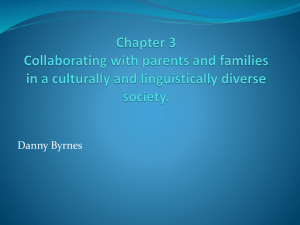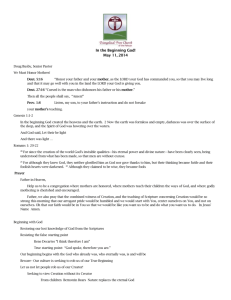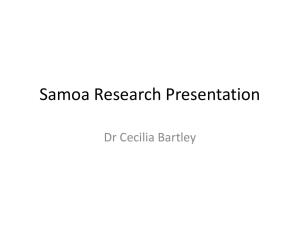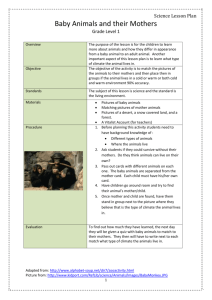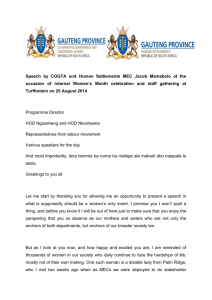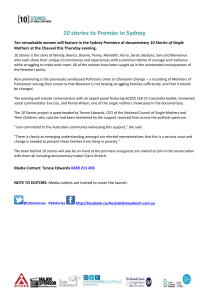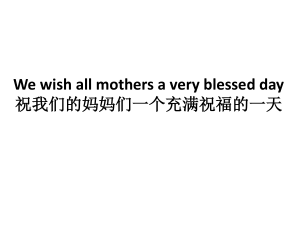Sharing the Maternal Care:
advertisement
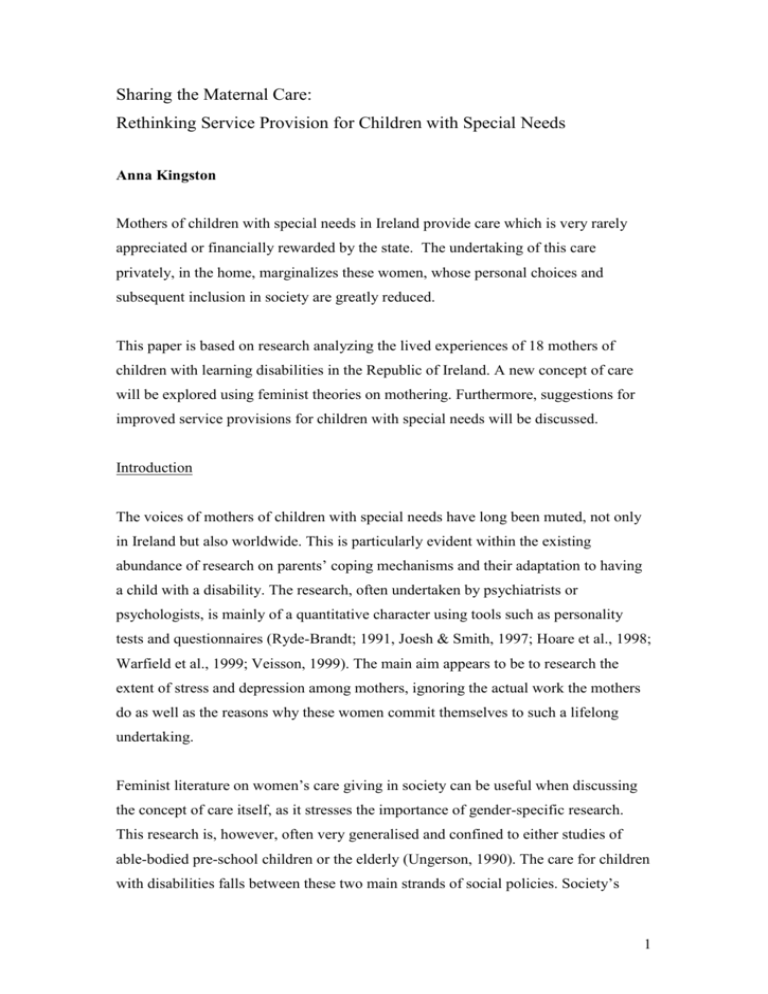
Sharing the Maternal Care: Rethinking Service Provision for Children with Special Needs Anna Kingston Mothers of children with special needs in Ireland provide care which is very rarely appreciated or financially rewarded by the state. The undertaking of this care privately, in the home, marginalizes these women, whose personal choices and subsequent inclusion in society are greatly reduced. This paper is based on research analyzing the lived experiences of 18 mothers of children with learning disabilities in the Republic of Ireland. A new concept of care will be explored using feminist theories on mothering. Furthermore, suggestions for improved service provisions for children with special needs will be discussed. Introduction The voices of mothers of children with special needs have long been muted, not only in Ireland but also worldwide. This is particularly evident within the existing abundance of research on parents’ coping mechanisms and their adaptation to having a child with a disability. The research, often undertaken by psychiatrists or psychologists, is mainly of a quantitative character using tools such as personality tests and questionnaires (Ryde-Brandt; 1991, Joesh & Smith, 1997; Hoare et al., 1998; Warfield et al., 1999; Veisson, 1999). The main aim appears to be to research the extent of stress and depression among mothers, ignoring the actual work the mothers do as well as the reasons why these women commit themselves to such a lifelong undertaking. Feminist literature on women’s care giving in society can be useful when discussing the concept of care itself, as it stresses the importance of gender-specific research. This research is, however, often very generalised and confined to either studies of able-bodied pre-school children or the elderly (Ungerson, 1990). The care for children with disabilities falls between these two main strands of social policies. Society’s 1 interest to provide care for non-disabled children is based on an interest to groom children into the adult world of paid work. The elderly dependents’ working lives are over, however, and so is the State’s interest in investing in care for them. Children with learning disabilities elicit a similar State response. Mothers of children with special needs, however, reject this categorisation, as I will show later in this paper, and work toward “grooming” their off spring for entry into the adult world. Dalley (1996), a feminist writer on caring, analyses the meaning of caring, and differentiates between “caring for” and “caring about”. “Caring for” has to do with the physical task of helping another person, whereas the “caring about” entails emotions. A mother is expected to do both, according to Dalley, and if she tries to separate the two concepts she is considered deviant. This blurring of the boundaries between functions typifies woman’s universe. In the domestic sphere, the menial tasks of family servicing are wrapped up and presented as part and parcel of her role as a mother, and given the same affective values as the feelings she has for the family members for whom she is performing these tasks. (Dalley, 1996:14) Having a child with a disability, a child whose dependency on the mother goes beyond what is normally expected, forces the mother to extend her affective links indefinitely. The large proportion of maternal time, in comparison to paternal time, spent with a child who is chronically ill, for example, is well documented (Dwyer et al., 1992). Men, according to Dalley, do not have this complicated dual role and they can “care about” without having to “care for”. As far as men are concerned, to care about is to be “responsible for” without having to do the actual tending. Thus the gender division of caring has consequences for official policies; women are natural carers (in the private and personal sphere) and men natural providers for care (which takes place in the public sphere). The mothering aspect of caring for a child with a disability is of great importance while trying to understand mothers of children with special needs, as their care differs greatly from, for example, women’s care provided for elderly spouses or parents. Ruddick’s (1989) definition of this maternal work is helpful in order to understand 2 this type of care. According to Ruddick, the basis for the maternal work is maternal thinking. This thinking is evoked by the child’s need to be “protected, nurtured and trained” (1989:23). Mothers of able-bodied children invest a lot of this maternal thinking and work in the early days of the child’s development. However, as the ablebodied child becomes more independent and trained, the mother can begin to let go. This is particularly true when the children reach school age and the State shares the responsibility for the child’s education. Many mothers of children with learning disabilities, on the other hand, are forced to provide this extra support for their children, mainly due to the lack of adequate service provision Kittay (2002), an American philosopher, is one of a few feminist writers who have contributed to the caring debate in the context of people with intellectual disabilities. She is herself a mother of a grown up daughter with a severe learning disability and she criticises the liberal society’s tendency to rely on goodwill and charity in providing care for its dependent citizens. She calls for a caring based on justice where dependence is positively acknowledged and met by a collective responsibility (2002:272). In this caring concept, society values both caretakers and caregivers and recognises their rights as human beings. Kittay argues that although her daughter cannot “pay back to society anything of material value” (p.273) her contributions are nevertheless great: “Watching her grow and develop skills and take part in her accomplishments nurtures me as much as my own work” (p.273). Kittay, however, decided to “share her mothering” with her husband as well as her Irish nanny Peggy (1999) as she wanted to be able to move on with her life, despite having a child with a severe learning disability. She, and her husband, wanted to pursue their professional careers, their parenting of their other child, their leisure activities and other things in life that they love, not only for their own sake, but also so they could keep loving their daughter without feeling resentful. We have moved to a model, which for want of any other adequate term I’ll call “distributed mothering”. I am Sesha’s mother; but in truth her mothering has been distributed across a number of individuals: father, various caretakers and Peggy. (Kittay, 1999:13) 3 According to Kittay, a mother with a disabled child puts her heart and mind into her mothering, not so much to “foster independence” as to “enable development”. That is a great challenge itself, involving “navigating complex straits” (Kittay, 1999:21). In order to realise this sense of accomplishment, the mother needs to know that what she is doing is the best she can do, which in turns means that she needs access to knowledge, financial, medical and educational resources. Kittay also takes issue against the Social Model in disability research, which ascribes many problems relating to disabilities to society itself. “Dependence is often socially constructed – all dependence is not. If you have a fever of 105, the dependency you have is not socially constructed” (Kittay, 1999:17). Realising that Sesha will always be extremely dependent, her mother stresses the crucial importance of creating a suitable environment for her. This was also high-lighted by the mothers who participated in my recent study. The Study This research was borne out of my own personal experience of mothering a child with autism, epilepsy and a mild learning disability. There was a striking void of research representing the voices of women like me, both in Ireland and internationally, and I intended to address that void. The chosen methodology, a feminist ethnography, facilitated a positive research partnership with the participants who were given an opportunity to provide feedback both on research findings and the research process itself. 18 mothers were recruited by selective sampling, the majority responded to a research letter that was sent out to various disability organizations, but also through my own personal involvement in support groups. The mothers had children diagnosed with Autistic Spectrum Disorder (ASD), Attention Deficit Hyperactivity Disorder (ADHD) and/or Down Syndrome. To limit the study, the children were born between 1992 and 1994, and the vast majority happened to be boys. The sample group was heterogeneous, with women coming from various socio-economic backgrounds and living both in rural and urban parts of the country. 4 An initial semi-structured, tape-recorded interview was held with the mothers, followed up with a meeting approximately one year later. Several themes were explored during the course of the research such as maternal coping, maternal work and employment as well as mothers’ relationships with fathers, families and networks in society, such as disability organisations. No Services – Mothers Ignored The findings suggest that Irish mothers of children with special needs, similar to their peers across the world, made huge personal sacrifices in order to provide support and education to their sons and daughters. It clearly emerged through the narratives that these women had very few choices, as services either were inadequate or did not exist at all. The Irish State has historically left the responsibility for caring for all children on the individual family. This has recently been high-lighted in the current debate on the lack of quality and affordable childcare for working parents. In the case of a child with a disability, services are very thin on the ground and mothers were practically ignored in their attempts to get support: He was referred to the Health Board, so we went for an assessment and all that kind of thing, who referred him to the Service Provider, who put him on a waiting list, and said: Sorry, we have no space, no room at the inn… (Caitriona, mother of Donnacha, autistic with a moderate learning disability) I wrote to the head of the services, and no reply, this is over a year ago, nothing, and I called the office a few times, and I got absolutely no reply. I just wanted to see was there any services available… (Marie, mother of Kevin, Asperger syndrome (high functioning autistic) Most striking in this study was how the mothers selflessly accepted their roles as mothers, without voicing any of their own needs or personal aspirations. Their own 5 well-being was solely discussed in the context of their children’s well-being, regardless of whether it entailed the present or the future. Thus, mothers’ viewed themselves very much in accordance with the role ascribed to them in the Irish Constitution in 1937. They identified themselves as primary care givers for their children, referring to a different way of thinking which was specific to women. All my 18 participants engaged in the maternal thinking and work (Ruddick, 1989) with little or no support from the fathers. Instead, my findings support existing research on Irish families confirming a stereotyped division of labour (McKeown, 1998) …The maternal thinking is different, it’s needed and he’s not great organising the house, he’s just a typical man… (Margaret, mother of four children with special needs) Well, our [husband and her] worlds are entirely different. I’m at home with the children all day, by choice, and I would be more tuned in, I think, to their needs, and to where they’re at, and to things that concern them…. My husband, I believe, has an equally important role to play in the family. The boys idolises him. (Helen, mother of Andrew, Down syndrome) One research question explored in the study was whether or not parents could influence professionals in decisions regarding educational and respite placements. All 18 participants felt that they, at various stages of the child’s life, had limited input in decisions regarding their child’s school placement. Although mothers were consulted, the final decision regarding educational and respite services was in the hands of professionals. Mothers either accepted this service or decided to educate their children at home. As a consequence, there was no real choice available to those mothers who were forced to take whatever was offered to them. Marie, for example, was appalled at the conditions of the building where her son was expected to receive his education: I remember being horrified when I saw the building, because the then Minister of Education came to see it...and I remember thinking is he not shocked that six little boys started school in basically a shed…? And obviously he wasn’t, 6 because he cut the ribbon and we had tea and scones and everybody celebrated, looking back I don’t know what the hell we were celebrating because it was awful, but I had to go along with it because at least then we were in the system… (Marie, mother of Eoin, autistic with a severe learning disability) Although being “inside the system” provided some help to mothers, the majority of my participants nevertheless spent hours doing extra-ordinary maternal work with their children. The amount of time and the type of work involved, however, varied depending on the circumstances. For mothers of children with severe and moderate learning disabilities, the maternal work invested was similar to that of caring for toddlers. Mothers of children with high-functioning disabilities, on the other hand, focused on social skills training and behaviour. I went out and got them a computer and just got them tremendous amount of programmes for every age group, I mean from toddlers, you know, and then we would do things like, I labelled everything in the house, and you just, you kind of learn how to teach these children… (Brenda, mother of Susan and Sally, Asperger syndrome) I then felt that this was a way of putting in time when he’s much smaller…because he’s younger he’s far more ready to soak up information than when he’s older, so if I put in a lot of effort now, that it would actually save me a lot of effort later on, and hopefully keep him in mainstream all the way through… (Miriam, mother of William, Down syndrome) I work with him all the time really…social stuff I do with him, I suppose I do it constantly….and if I didn’t, where would he be, you know, there’s no one else…It’s a full time job. (Mary, mother of Kevin, Asperger syndrome) 7 Paradoxically, the mothers’ decisions to perform maternal work did not reduce them to passive dependants, confined silently to the private sphere in line with their socially constructed role in the constitution. Instead of looking for support from professionals and the State, they turned to other sources of information as active agents for their children. The Internet played a vital role for many mothers in their search for new ways to train and educate their children. Others discovered new teaching methods by consulting literature on alternative therapies. An important finding in this research was the notion that if the mothers did not do the extra-ordinary maternal work themselves, nobody else would do it. This notion was expressed in statements like these: “If I don’t keep on top of it, nobody is going to do it. So I just got to do it” (Mary), “If I had gone out to work, what would have become of my son” (Julie) and “I’m his mother, like if I’m not going to do it, who is going to do it?” (Margaret). These mothers had set certain standards of care and education related to their children’s needs. As the State failed to provide this standard of service provision, they were forced to provide it themselves. The majority of these mothers, however, would have preferred if services were in place to assist them in this work. Redmond (2003) documented similar views on preferred care in her research of mothers of young children with severe learning disabilities. Thus, her mothers’ willingness and preference to be main caregivers, did not exclude demands for assistance and support. Similarly, one of my participants had benefited from the type of shared mothering described earlier in this paper (Kittay, 1999). Mary, mother of Patrick, diagnosed with autism and a severe learning disability, spoke about her sense of ease as care staff took over her work: And, you know, I just gave up on feeling guilty not having enough time to devote to Patrick, I was going to feel guilty for the rest of my life, because I was never going to be able to give him all the time he needed. And that’s where the home support and the extra bit of help comes in. I’m much happier because I know Patrick is getting it, and I know it’s stuff Patrick loves and he’s enjoying it and he’s also progressing with this bit of support. And I don’t 8 think I’d be able to do it as well as the girls, because I would be, I’d be under more stress. (Mary, mother of Patrick, severely learning disabled) This is an example of how community based care staff can successfully provide support without necessarily sharing the mother’s love for the child. Furthermore, it leaves room for the mother to fulfil her own personal aspirations and needs. In order to facilitate for the mother’s inclusion in society, we need to address care provision at two different levels. One level involves service providers and policy makers who need to involve mothers as genuine partners. The second level concerns the education of care-workers on the ground based on mothers’ knowledge and handson experiences. Implications for Services There is a major difference between the practical care giving work as employment and as life-long mothering. Whereas the mother usually follows the child throughout many of his or her different stages in life, staff will come and go. Thus, the mother feels compelled to hold a firm grip, as only she knows the full story. A lack of understanding of the mother’s firm grip can contribute to her being dismissed by professionals as over-anxious or militant. One of my participants, for example, expressed this feeling of being judged by professionals, as she asked to read a report on her child: “I sometimes think they think I’m hysterical…” (Margaret). That quote suggests an existing imbalance in power, where mothers frequently experience patronizing attitudes from professionals in a traditional top-down relationship. Thus, Ireland is still only paying lip service to concepts of genuine partnerships despite key policy documents such as the Task Force for Autism (2001). Professionals and service-providers can help to improve the situation for mothers of children with learning disabilities. The narratives of the mothers in my study point to the need for systemic changes in attitudes and practices among professionals such as paediatricians, psychologists, psychiatrists, educational staff, social workers, care staff and therapists. Firstly, an environment of empathy and compassion is essential, 9 as well as support with all available resources at hand. Secondly, although mothers do know their children best, they are in great need of support from experts whom they expect would have the specialised knowledge needed to improve the child’s quality of life. Conflicts between mothers and professionals can also be minimised, by maintaining ongoing communication between everyone concerned. In practical terms, this means introducing genuine partnerships regarding social policies and service provisions for children with special needs. The word “partnership” has been used extensively in research on families living with disabilities (Dale, 1996; Case, 2000; Knox, 2000; Murray, 2000; Sloper, 1999). In order to avoid the term becoming a cliché, the meaning behind a true partnership has to be spelled out, and more importantly, it has to be implemented. A partnership begins by professionals listening to mothers and taking their views seriously. Listening is, however, not enough. I argue that a true partnership entails mothers and professionals involved together, on equal terms, in planning and implementing services. In a genuine partnership, mothers should have the right to the same financial and organisational power as the service provider or policy maker. Furthermore, in order to reach standards of service provisions set by mothers of children with special needs, we need to focus on the mother’s wish to seek full potential for the child as a human being and make this central to the care work. We need to re-think the notion of dependency, as suggested by Kittay (1999), and educate professionals accordingly. Society expects mothers to provide both the practical and the emotive care for the child, whereas professionals are only expected to do the practical, the “caring for”. Re-thinking this concept of care means that professionals share this dual caring with mothers. In other words, care-workers would care for the child in the same way that they would care for somebody close to them, care for and care about. An example of bad and de-personalised care practice was revealed to me recently by a mother of a 14-year-old girl with autism. This girl has long, thick hair flowing down her back and the mother helps her with the washing and the brushing as part of her extra-ordinary maternal work. The care-workers, however, feel that this is adding to 10 their workload and constantly put pressure on the mother to cut her daughter’s hair short. In this case, the girl is de-humanised and treated purely as an object. It is understandable that this particular mother prefers to care for her daughter herself, as the support offered is unacceptable to her. Instead of considering the person being cared for as a passive “burden”, we must adhere to the values of human rights. Governments resist investments in children with learning disabilities, as they are not considered to be able to pay society back. Mothers such as Kittay, however, do acknowledge the value of their children’s contributions to society. Sesha’s smile, for example, is an expression of her joy, which in turns contributes to Kittay’s feelings of satisfaction. This acknowledgement, in my opinion, should also be reflected in the form of “work satisfaction” for care giving staff in the community. My research has shown that some professionals are able to share these values with mothers in the form of positive feedback. One participant, for example, recalled the headmaster ringing her to say that her son was behaving well: “and he says ‘I thought I’d ring you with a more positive phone call than all the negative ones you get” (Anne). Thus, positive input from principals, speech therapists, individual teachers and respite staff was praised accordingly. One important conclusion that can be drawn from this research is that many mothers of children with special needs in Ireland are willing to share their extra-ordinary mothering with other people. If they were given a real choice, and if they could trust their care of the child with somebody else, they could begin to think of themselves and their own needs. This is a small, but important step, towards equality and inclusion of this isolated group of women in Irish society. This research was supported by grants from Irish Research Council for Humanities and Social Sciences and National Disability Authority (NDA). Correspondence to Anna Kingston: Address: Knockalisheen, Togher, Cork. 11 Telephone: 00 353 21 434 18 92 Email: kajsa@iol.ie 12
